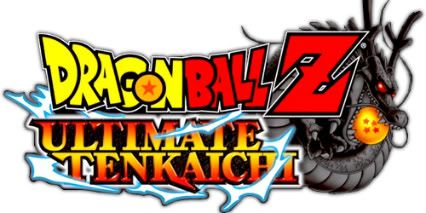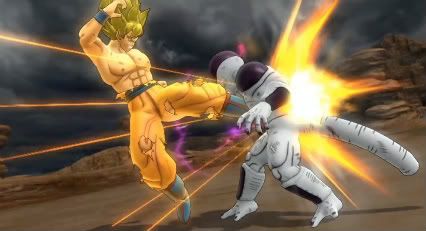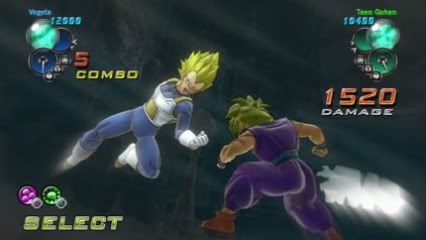
- Format: PS3 (version reviewed), 360
- Unleashed: Out Now
- Publisher: Namco Bandai
- Developer: Spike
- Players: 1-2
- Site: http://www.namcobandaigames.com/console/dragon-ball-z-ultimate-tenkaichi
Originally given the mysterious mouthful of a title Dragon Ball Game Project Age 2011, it eventually transpired that the spiritual successor to the Raging Blast, Budokai and Tenkaichi games based in the Dragonball universe was given the slightly more reasonable title of Ultimate Tenkaichi.
Long term fans of the original manga or animé will be more than familiar with the plot, and even newer fans brought in by the Kai release will know enough. Dragonball Z is about two shirtless men spending about five minutes powering up and then another five minutes punching each other, which sounds like the perfect thing to translate into a fighting game – and it has been for many years now.

There are the basic modes you would expect in any beat ’em up; with a versus mode for battles against a friend in the room or AI opponents (with tag variants also available for battles including three or more characters), an online mode for matches, tournaments and a tutorial/training mode which is far clearer than recent games.
The game before this (Raging Blast 2) caused consternation by excluding a story mode from the game and instead introduced Galaxy Mode. Ultimate Tenkaichi has taken a few steps back and once again includes the classic Dragonball Z story from start to end, with fleeting encounters against enemies only seen in the movies and also the final enemy from the subsequent Dragonball GT. However, huge chunks of the plot are explored only via walls of text split between brief exploration sections and battles.
What is probably most infuriating about the story mode is that it actively mixes the old dubbing cast from Dragonball Z with the new cast brought in for Dragonball Kai. Characters literally change voice from one sentence to the next on occasion. It is unacceptably cheap, lazy and pathetic to think it was passable to do this. This is not an argument for or against the cast of either dub or even if the original Japanese is the better choice (which is also included); it’s purely about an incredibly stupid decision that ruins multiple cutscenes and battles.

Perhaps it would be possible to forgive such a lazy story mode if there was more to the game. You may have noticed that the graphics are top notch, which they are (though every single playable stage is recycled from Raging Blast 2 more or less) and battles are suitably over the top with destructive scenery and impressively large special attacks. There are also large boss battles that lift heavily from those found in Naruto Shippuden Ultimate Ninja Storm 2. However, there are more problems.
The game is cinematic to the point where it stops being a game and is an example of something which is probably more fun to watch than play. In either an effort to make the game more dramatic and reminiscent of the animé or to remove complaints players had in previous games (certain irritating tactics in online play) most of the fighting has been boiled down to a game of heads or tails.

When trying to gain distance from an opponent, or get in close, or attack with the one combo all characters have, or try to counter, a button press will be required which has two options. If your opponent presses the same as you then you lose (so if you had started a combo they counter it). Fights quickly boil down to the same 50/50 chance of attacking or being attacked over and over – at least until you realize that the CPU will always have a particular preference and once you know what it is that makes any battle ridiculously easy. Repetition soon sets in as every battle plays out in exactly the same way over and over and kills any perceived belief that skill matters for anything in Ultimate Tenkaichi because it doesn’t – it’s just luck.
The innovations brought in aren’t all bad though. Reaction commands based on varying amounts of stored Ki which allow you to block, evade or counter an incoming special attack help balance things out, and special attacks themselves are no longer connected to stored Ki and instead are based on a separate spirit bar which builds from landing combos. This helps remove special move spamming which plagued previous Dragonball games. Finally, the hardest hitting ultimate attackers are totally locked out until either you or your opponent are near death.
Hero Mode is another good new addition where you can make your own unique character based on three builds, which you can then equip and take through a fairly short what-if story set alongside established characters. You can customise the look of your character (though the selection when you start is very limited) and level up various statistics by taking part in battles and training under different masters to learn their techniques.
As with most games based so heavily inside the universe of an animé it already has an established niche market, and will be ignored by everyone else. But even for fans – even for the most dedicated ones – Ultimate Tenkaichi has strayed too far from what a proper fighting game is into experimental territory that unfortunately just turned out bad. The game is worth renting for Hero Mode and to try out the cinematic battles for a little while, but beyond that fans would be better off returning to previous games rather than Ultimate Tenkiachi.



I Think this is the best review of the game, is the same i think when i played the game, i think if they really put some spirit creating the game and more time, it’ll be an awesome story mode, and like you say, that thing of pushing Y or X – X or Δ, it’s just luck, when i played with my brother 1P vs 2P we think this just suck, no matter how good are you in the game the luck is everything :/ and the Hero Mode needs more customization, and they did’t put other races, only saiya-jin D:
but if you look at the box of the game, you’ll see that it say “Downloable Game Content”, what means there will be DLC, i hope they add more chars, but i think is improbable =/
Well.. nice review, one of the best.
Sry for my bad english.
The 50/50 coin toss button pressing thing was implemented perfectly in DragonallZ Budokai 3 on PS2 by Dimps. Where you controlled when it was inititated and used the four face buttons for 3 tries. If the same button was pressed; 1st button press results in a counter-attack by the defender, if the 2nd was a success its a block and if the defender got it right 3rd time you’d be hit but not full force. Of course to get the 3rd part the attacker would have to be successful each time and the face buttons you could press each time reduced by one each time I think, been a while since I played.
BUDOKAI 3 was the most balanced version of dragonball z and whilst spikes attempts have been great, I’ve always felt there was something lacking.